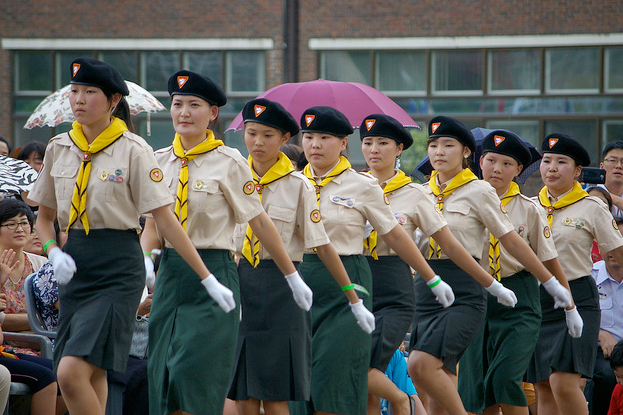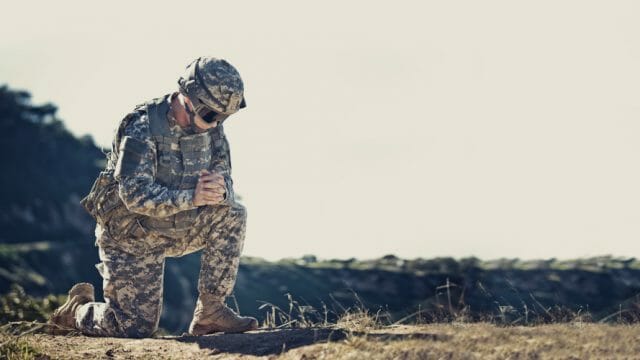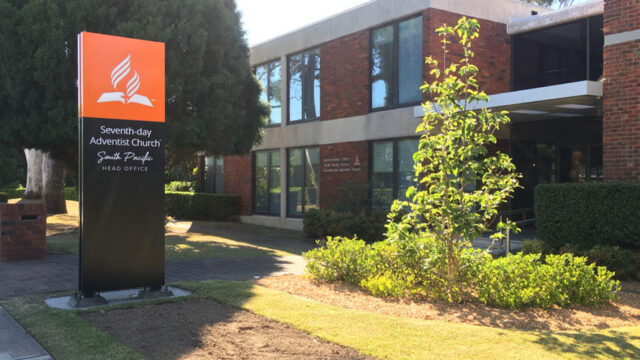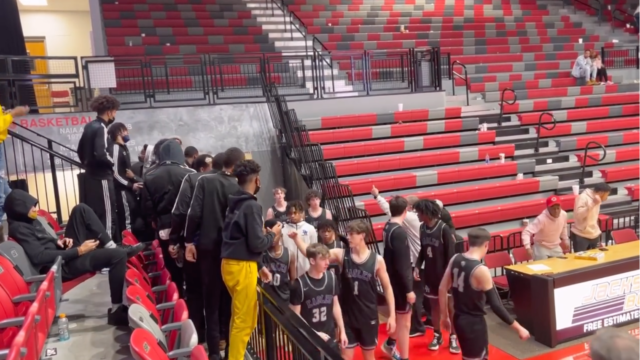Following the trail of the first Pathfinders

A message to tell to the world, a truth that will set us free,
King Jesus the Saviour’s coming back for you and me.”
Do you recognize these words? Did you merely read them, or did you find yourself singing along? If the answer is “yes” to either of these questions, you may have been a Pathfinder, or perhaps you are one now. But how much do you know about this community-service-oriented, character-building youth organization?
Learning Pathfinder history is as exciting as going on an abseiling expedition, and following its course as varied and detailed as geocaching.1
Follow along as we chart the colorful history of the Pathfinder Club.
Starting Big
While formally recognized in 1950, the youth movement in the Seventh-day Adventist Church that led to the formation of the Pathfinder organization began in 1907. According to The Pathfinder Story,2 by 1907 it had become clear that the Adventist Church’s youth work required a department of its own.
The General Conference (GC) voted to establish the Young People’s Department. During the next three decades work started by Luther Warren, Milton E. Kern, Matilda Erickson, Arthur W. Spalding, Harriet Holt, and C. Lester Bond catapulted the youth movement into overdrive at, it seems, the speed of light. Here’s a quick summary of some of these individuals’ contributions:
Luther Warren began “Sunshine Bands” in South Dakota in the late 1800s, beginning a life of working with church youth at age 14. These groups involved youth in community outreach and later became part of the mission of Pathfinder Clubs.
Milton E. Kern was the first director of the GC Young People’s Department (later named Youth Department) in 1907. He developed the Standard of Attainment, which became the forerunner and basis for the Progressive/AY Classes.3
Matilda Erickson, Kern’s assistant, developed materials for junior youth, including materials such as the Morning Watch, a short daily devotional plan based on a calendar year. Around the world these are still popular—and integral to keeping the Pathfinder Law.
In 1919 Arthur W. Spalding organized a small group of boys in Tennessee into a club he dubbed “Mission Scouts.” Not only did they go camping; they were involved in “doing good deeds” in their community. They also put together a pledge and law that later became the pledge and law for the Junior Missionary Volunteers (precursor to Adventist Junior Youth/Adventist Youth). This is still the guiding light of Pathfinder Clubs.
Following the examples of outdoor activities by Spalding and others across the United States, Harriet Holt, hired by the GC Youth Department in 1920, started outdoor activities, handcrafts, and outreach events for girls. These outdoor activities, including canoeing and camping, led Holt to develop Friend and Companion designations for the Junior Missionary Volunteer (JMV) Society, as well as leadership training called Comrade and Master Comrade.4
C. Lester Bond, Holt’s successor (1928), continued to develop the first 16 vocational topics that eventually became honors. He added another 19 more during his 18-year term in the Youth Department.
Mapping It Out
Significant events in several places across the United States helped shape the modern Pathfinder organization. Camping and outreach events for youth were held in California, Tennessee, South Dakota, and the Washington, D.C., area simultaneously. But how did the name “Pathfinder” come into use?
According to The Pathfinder Story, in 1928 Spalding told the story of Western explorer John Fremont, whose nickname was “Pathfinder,” to a small group of youth campers from southern California led by John McKim. The nickname caught on, and soon the group carried the name “Pathfinder Club.”5
It was a few years before the name was used outside California, but once it became the youth organization’s official moniker, clubs spread like wildfire across the U.S. and subsequently the world. Indeed, in less than 10 years, Pathfinder Clubs could be found in several countries outside North America. Puerto Rico, Chile, India, Brazil, Germany, Sweden, South Africa, and Trinidad and Tobago are just a few of the places where Pathfinder Clubs sprouted. Several key people helped map out this dispersal.
Laurence Skinner, a youth director in the Pacific Northwest, launched several clubs he called “Trailblazers” in 1942. These clubs functioned much like other groups under the umbrella of the JMV Society, but they had a broader scope of activity. In 1950, Skinner became the first world Pathfinder director when at the GC session it was voted to accept the new program worldwide.
Just before Skinner started his 13-year tenure as world director, Southeastern California Conference youth director John Hancock worked with La Sierra College ministerial student, Francis Hunt, to start a club for boys and girls called Pathfinders. Other area churches did the same, and soon there was a club of 150 members run by Lawrence Paulson of the Glendale church.
Paulson, beginning in 1947, was responsible for starting and directing at least 11 other Pathfinder Clubs.6 Hancock designed the triangular Pathfinder logo and asked his colleague, Henry Bergh, to write a song for the organization.
In 1956 Nercida de Ruiz, director of Miraflores church’s club in Lima, Peru, introduced the Spanish name for the club as “Conquistadores.” Soon this name was adopted throughout Latin America, from Mexico to Argentina. Now, according to General Conference Youth Ministries, it applies to more than 200,000 Pathfinders.
Fine-tuning
No one person or club can be credited with the start of the Pathfinder program. It was a cumulative, synergistic, and simultaneous creation. But what makes Pathfinders unique from other scouting-type organizations for youth? How did we get the law, pledge, and song? What about the marching and the wearing of uniforms? The flag?
Again, no one person can be credited. And again, several people stand out as vital to the development of these components that combined to become the Pathfinder Club.
In 1921 Harriet Holt adopted and adapted a pledge and law Arthur W. Spalding had written for his club in Tennessee. This has since become the Pathfinder Pledge and Law.7 Standing the test of time, neither the pledge nor the law has been significantly changed since they were first issued. Thousands of Pathfinders each year learn and choose to abide by the requirements of the Pathfinder Pledge and Law for the purpose of growing closer to their fellow humans and to their Creator.8
Helen Hobbs made the Pathfinder flag in 1948. The flag bears the Pathfinder Club’s emblem (or logo) and is flown at local and conference Pathfinder programs and activities.
During the late 1940s and early 1950s, Clark Smith and Harry Garlick wrote the first drill manuals with advice from Henry Bergh, youth director for the Central California Conference, that they should “make them kinder and gentler than military manuals.”9
It is likely that the wearing of uniforms gained in popularity during this time. Pathfinder uniforms help make the Pathfinder program real and visible. It is emblematic and representative of the club’s ideals and standards. Wearing uniforms provide a consciousness of belonging to a club that rightly represents the Adventist youth of today.10
Bergh, author of the booklet How to Start a Pathfinder Club, can be credited with designing the Pathfinder flag that Hobbs made. Bergh was crucial to the movement in many ways, but perhaps the one feat that stands out most is the song he wrote.
Bergh was asked by John Hancock to write a song for the Pathfinder Club. According to GC Youth Ministries, “Henry was no musician, but while on his way to preach at a nearby church one Sabbath, [he] found himself thinking a sequence of words in a somewhat poetic form. He stopped by the road, took out a scrap of paper from the back of his Bible, and wrote out the words that came to him. On his way home from the same service, he found himself whistling an unknown tune. When he matched the tune to the words, they fit. He asked Wayne Hooper, well-known Adventist musician and composer, to review it and make corrections or modifications. Hooper sent it back unchanged, with a comment that none were needed.”11 A gift from God, the song is sung today in many languages around the globe.
Finishing the Hunt
Charting the path of the Pathfinder Club is no easy task. But one thing is certain: God was leading the church when it developed this organization for children and youth ages 10 to 16. Just as the church began as a small movement, just as the Adventist Review started as “a little paper,” Pathfinder Clubs started small with groups, ideas, ideals, and dedicated people. They coalesced and exploded around the world.
No matter how hard one tries, the story gets abbreviated, lost in time, less precise. And while it is easy to reduce the story to a few names and dates, we should not forget that many people who loved God put their life’s efforts into the Pathfinder cache. They were the ropes and pulleys that have held this organization together.
So the hunt for the history of Pathfinders ends and begins with you. As an insightful writer put it: “The true heroes are the youth of the past, present, and future who follow our aim, ‘The Advent message to all the world in my generation.’”12
1 Abseiling is a South Pacific Division Honor; Geocaching is a North American Division Honor.
2 Robert Holbrook, Ed., The Pathfinder Story (2006).
3 From the General Conference Youth Ministries web site, gcy.bigfoottech.com/ABOUTUS/OurHistory/tabid/191/agentType/ViewSearch/PropertyTypeID/85/Default.aspx.
4 These names were changed to Guide and Master Guide in 1951.
5 The club met in McKim’s home. Other clubs in nearby towns, working on the classes Friend and Companion, and doing Honors and witnessing, picked up on the name.
6 The Pathfinder Story, p. 15.
7gcy.bigfoottech.com/ABOUTUS/OurHistory/tabid/191/agentType/ViewSearch/PropertyTypeID/87/Default.aspx.
8pathfindersonline.org/html/leadershipresources/about/about_pledge_law.htm.
9 The Pathfinder Story, p. 17.
10gcyouthministries.org/Ministries/Pathfinders/UniformSpecifications/tabid/88/Default.aspx.
11gcy.bigfoottech.com/ABOUTUS/OurHistory/tabid/191/agentType/ViewSearch/PropertyTypeID/89/Default.aspx.
12gcy.bigfoottech.com/ABOUTUS/OurHistory/tabid/191/agentType/ViewSearch/PropertyTypeID/85/Default.aspx.








